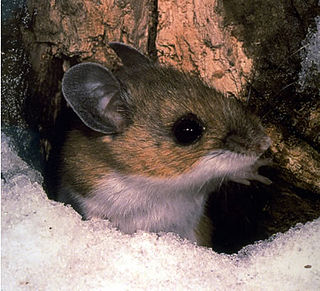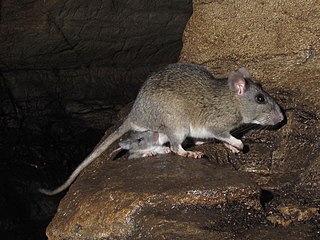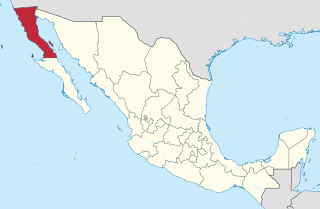
The Neotominae are a subfamily of the family Cricetidae. They consist of four tribes, 16 genera, and many species of New World rats and mice, predominantly found in North America. Among them are the well-known deer mice, white-footed mice, packrats, and grasshopper mice.

The eastern woodrat, also known as the Florida woodrat or bush rat is a pack rat native to the central and Eastern United States. It constructs large dens that may serve as nests for many generations and stores food in outlying caches for the winter. While widespread and not uncommon, it has declined or disappeared in several areas.
The Mexican woodrat is a medium-sized rat occurring in the United States from Utah and Colorado south through New Mexico and parts of Arizona and Trans-Pecos Texas. Its range continues south in the highlands to Honduras. Although occurring at lower elevations during the Pleistocene, it generally is limited now to highlands supporting open coniferous forests or woodlands. In a few places, it occurs in lower country where lava or boulder fields occur; presumably the presence of spaces extending far below the surface enables survival. Like most members of the genus living in rocky areas, dens tend to take advantage of crevices, rock shelters, and caves; stick nests are relatively rare.

The Allegheny woodrat, is a species of "pack rat" in the genus Neotoma. Once believed to be a subspecies of the eastern woodrat, extensive DNA analysis has proven it to be a distinct species.

The white-throated woodrat is a species of rodent in the family Cricetidae. It is found from central Mexico north to Utah and Colorado in the United States. It is primarily a western species in the United States, extending from central Texas west to southeastern California. Populations east of the Rio Grande in New Mexico and Trans-Pecos Texas, previously considered to be variants of the white-throated woodrat, have since 1988 been assigned to the white-toothed woodrat.
The Tamaulipan woodrat is a species of rodent in the family Cricetidae. It is found only in Mexico.
Bryant's woodrat is a species of rodent in the family Cricetidae.
The Nicaraguan woodrat is a species of rodent in the family Cricetidae found in Honduras and Nicaragua.

The bushy-tailed woodrat, or packrat is a species of rodent in the family Cricetidae found in Canada and the United States. Its natural habitats are boreal forests, temperate forests, dry savanna, temperate shrubland, and temperate grassland.
The Arizona woodrat is a species of rodent in the family Cricetidae. It is found in Mexico and United States.

The dusky-footed woodrat is a species of nocturnal rodent in the family Cricetidae. They are commonly called "packrats" or "trade rats" and build large, domed dens that can reach several feet in height. Coyotes and other predators will attempt to prey on these rodents by laying waste to the dens, but the sheer volume of material is usually dissuasive. Occasionally, dusky-footed woodrats will build satellite dens in trees. Although these animals are religiously solitary, except in the mating season, dens are frequently found in clusters of up to several dozen, forming rough "communities". The mating system in this species appears to be variable, with promiscuity most generally at high population densities and monogamy at lower densities.
Goldman's woodrat is a rodent species in the family Cricetidae. It is found only in Mexico throughout the Mexican Plateau, stretching from Southeast Chihuahua to South San Luis Potosi and North Queretaro. The plateau is an average 5,988 ft. above sea level and covers a land area of 232,388 sq. miles.

The Southern Plains woodrat is a species of rodent in the family Cricetidae. It is found in northwest Mexico and in Colorado, Kansas, New Mexico, Oklahoma, and Texas in the United States.
Nelson's woodrat is a species of rodent in the family Cricetidae. It is endemic to Mexico, where it is known only from the eastern slopes of the volcanoes Orizaba and Cofre de Perote.
The Bolaños woodrat is a species of rodent in the family Cricetidae found only in Mexico.
The Sonoran woodrat is a species of rodent in the family Cricetidae found only in Mexico.
Stephen's woodrat is a species of rodent in the family Cricetidae found in Arizona, New Mexico and Utah in the United States.
Neotoma leucodon is a species of rodent in the family Cricetidae. Although originally named from San Luis Potosí, Mexico, as a species by Merriam, the white-toothed woodrat was long considered to be a synonym of the white-throated woodrat. Molecular data, however, indicate the populations east of the Rio Grande in New Mexico and Trans-Pecos Texas represent a different species than morphologically similar populations west of the river.
The big-eared woodrat is a species of rodent in the family Cricetidae. A study of the species found the "Bear Canyon" virus, a mammarenavirus, traditionally associated with the California mouse, is actually passed by the big-eared woodrat before host-jumping to the California mouse.

A pack rat or packrat, also called a woodrat, can be any of the species in the rodent genus Neotoma. Pack rats have a rat-like appearance with long tails, large ears and large black eyes. Compared to deer mice, harvest mice and grasshopper mice, pack rats are noticeably larger and are usually somewhat larger than cotton rats.










